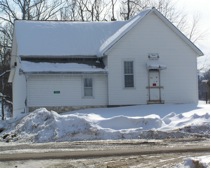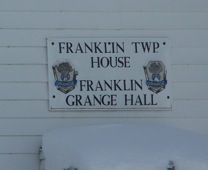The history of an area can help explain its culture and people. Events of history may either unite or divide a community. Such events may further serve to inspire community activities, government, business, and neighbors.
The prehistoric history of Franklin Township is documented by the extensive earth works created by Moundbuilder Indians. Several earth works are located within Franklin Township.
 |
 |
The first, a large stone mound one half mile south of the center of the township, had an original diameter of 40 feet, and was described by an early surveyor as “a singular pile of stone.”
The well known “Tippett” mound located a few hundred yards east of Linnville Road had a base diameter of 75 feet and was 21 feet high.
Nearly a mile east of Tippett mound, and about the same distance northeasterly from the above stone mound was a “fort of low banks,” but no accurate dimensions of this earthwork are available.
A stone mound is also located near the Madison Township line one half mile or more from Claylick, along with seven more mounds of greater or less magnitude located primarily in the southeastern portion of the township.
Early attempts to open the mounds for their contents began to change the earth works dimensions. As the township continued to develop, the stones from some of the mounds were used to make roadbeds, and as agricultural plowing increased, the original dimensions were greatly altered.
In recorded history, Franklin Township is composed entirely of United States military lands and was part of the extension tract dedicated by the government to the payment of officers and soldiers of the American Revolution. The act of Congress passed June 1, 1796, authorized the survey, and Franklin Township appears on the plat of the original survey as in the first tier townships in the eleventh range.
Franklin Township was first settled in 1805 by George Ernest, john and Jacob Switzer (which later became Swisher) and John Feasel. These settlers came from the Shenandoah Valley of Virginia and were of the Lutheran faith.
Other early settlers were: Daniel Motherspaw, Henry Burner, Jacob Row, Jacob and John Fry, John Wilkin, Uriah Hull, and a Mr. Dustheimer. All of these pioneers came from either Pennsylvania or Virginia and settled in Franklin Township in or before the year 1812, when the township was organized and named in honor of Benjamin Franklin.

In Hill’s history of Licking County, dated 1881, the residents of Franklin Township are described as “almost wholly given to agriculture along with being quiet, honest, successful, sober, industrious, frugal and hospitable. The township residents are also know for giving no encouragement to vagabonds, demagogues, busybodies, or to the idle or lazy, to loafers, vagrants, horse-jockeys, speculators, professional office seekers, note shavers, whiskey drinkers, nor indeed any who are engaged in vicious and demoralizing pursuits.”
The settlers of Franklin Township were very interested in education and the Lutherans erected one of the first hewed-log structures which served as both a church and a schoolhouse. At one time, the township was divided into seven school districts, some of which remained into the early to mid-1900’s. In 1939, the Franklin Township School was erected by the WPA and served the township as an elementary school until it was closed in 1981.
Most of Franklin Township is in the Lakewood School District with a fractional portion being in the Licking Valley Local School District.
Franklin Township’s early settlers brought with them a strict code of ethics and a strong emphasis on religion. The first settlers were of Lutheran faith, but the first religious society in the township was the Methodist Society begun in 1809, which erected a hewed-log building in 1818 on the site of the old Ellis Chapel.
To date, the township has a Lutheran and a Baptist Church.
During the 1800’s and mid-1900’s, Franklin Township was entirely rural, having no villages and few small businesses. The churches, schools, Grange and homes were the social gathering places for the population. By the 1950’s and 1960’s, changes began to occur and the population increased.
Decreased agricultural profits, along with more opportunity and access to Newark and other cities, led to a gradual decline in farming in the township. As farms were sold, homes were constructed by both long-time residents and newcomers. No villages have yet emerged, and Franklin Township still has only a few small businesses.
Franklin Township has great natural beauty, which is one of the main reasons that people reside here. After decades of change, Franklin Township may now best be described as a diverse population in a picturesque rural setting.
The rural atmosphere and way of life are responsible for holding many lifelong residents in the area, as well as attracting new residents to choose the township for their home. The open farmlands and woodlands provide an excellent environment for the young and old alike, and you can find many second and third generations stating in the area. A drive through the township will make it obvious why people purchase property in this scenic township. The lands within the township have been well maintained over time, and we owe a debt of gratitude to the many people that have tended the area over the generations.
For further information on the history of Franklin Township, see The History of Licking County Ohio, N.N. Hill, 1881.